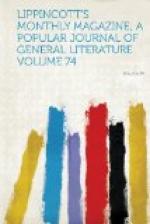We sent no steam fire-engines, no locomotives, and no cars. Our great printing-presses, since largely borrowed from and imported by Europe, were scarcely noticed. Not so with “a most beautiful little machine” for making card wire-cloth, copied from America. Recognition of the supreme merits of the pianos of Chickering, Steinway and the rest was still wanting, Erard’s Parisian instruments bearing the bell. Borden’s meat-biscuit—to revert to the practical—caused quite a sensation, the Admiralty being overloaded with spoiled and condemned preserved meat. The American daguerreotypes on exhibition were pronounced decidedly superior to those of France, and still more to those of England. Whipple displayed the first photograph taken of the moon, thus securing to this country the credit of having broken ground for the application of the new art to astronomy. No photograph of a star or of the sun had been obtained. The distance between the United States and Europe in the application and improvement of photography cannot be said, notwithstanding our advantage in climate, to have been since widened. A field of competition still lies open before them in the fixing of color by the camera and the sensitive surface. The sun still insists on doing his work with India ink and keeping his spectral palette strictly to himself. For cheap and popular renderings of color man was then, as now, fain to have recourse to the press. The English exhibited some chromatic printing, far inferior to the chromo-lithographs of today.
And this brings us to art. One out of thirty in the programme, it was, as it always will be on these occasions, nearer thirty to one in the estimation of assembled sight-seers. The dry goods and machinery, even the bald, shadeless and ugly (however comfortable) model cottages of the inevitable Prince Albert, failed to draw like the things which flattered the lust of the eye; as the pigs and pumpkins of an “agricultural horse-trot” attract but a wayside glance from the procession to the grand stand. We are all dwellers in a vast picture-gallery, with frescoed dome above and polychromed sculpture and mosaic pavement on the floor below. Its merits we perceive, enjoy and interpret according to our individual gifts and education. But it makes amateurs in some sort of every mother’s son or daughter, of us; and we hasten to plunge, confident each in his particular grammar of the beautiful, into the study of what imitative




